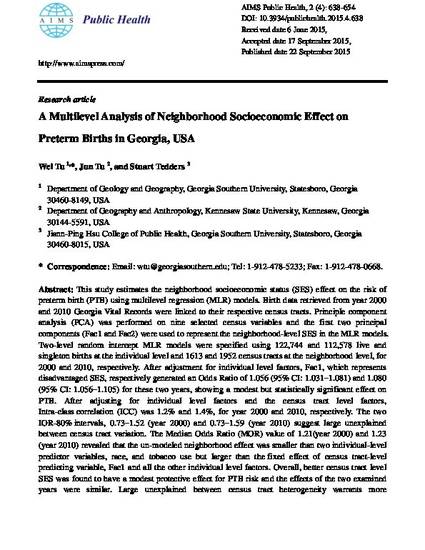
This study estimates the neighborhood socioeconomic status (SES) effect on the risk of preterm birth (PTB) using multilevel regression (MLR) models. Birth data retrieved from year 2000 and 2010 Georgia Vital Records were linked to their respective census tracts. Principle component analysis (PCA) was performed on nine selected census variables and the first two principal components (Fac1 and Fac2) were used to represent the neighborhood-level SES in the MLR models. Two-level random intercept MLR models were specified using 122,744 and 112,578 live and singleton births at the individual level and 1613 and 1952 census tracts at the neighborhood level, for 2000 and 2010, respectively. After adjustment for individual level factors, Fac1, which represents disadvantaged SES, respectively generated an Odds Ratio of 1.056 (95% CI: 1.031-1.081) and 1.080 (95% CI: 1.056-1.105) for these two years, showing a modest but statistically significant effect on PTB. After adjusting for individual level factors and the census tract level factors, Intra-class correlation (ICC) was 1.2% and 1.4%, for year 2000 and 2010, respectively. The two IOR-80% intervals, 0.73-1.52 (year 2000) and 0.73-1.59 (year 2010) suggest large unexplained between census tract variation. The Median Odds Ratio (MOR) value of 1.21(year 2000) and 1.23 (year 2010) revealed that the un-modeled neighborhood effect was smaller than two individual-level predictor variables, race, and tobacco use but larger than the fixed effect of census tract-level predicting variable, Fac1 and all the other individual level factors. Overall, better census tract level SES was found to have a modest protective effect for PTB risk and the effects of the two examined years were similar. Large unexplained between census tract heterogeneity warrants more sophisticated MLR models to further investigate the PTB risk factors and their interactions at both individual and neighborhood levels.
Available at: http://works.bepress.com/stuart_tedders/52/

© 2015, Wei Tu, et al., licensee AIMS Press. This is an open access article distributed under the terms of the Creative Commons Attribution Licese (http://creativecommons.org/licenses/by/4.0)